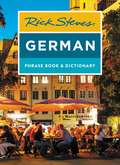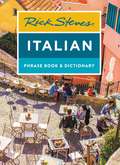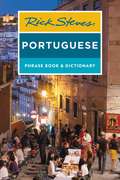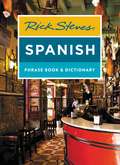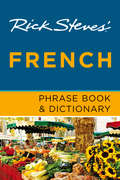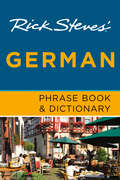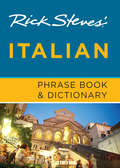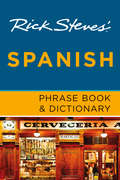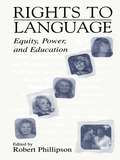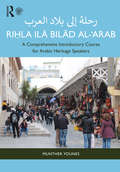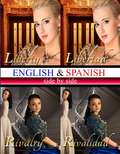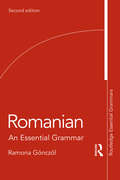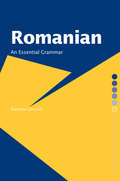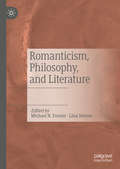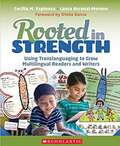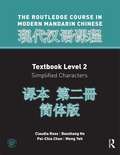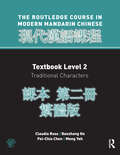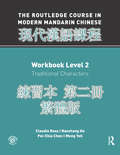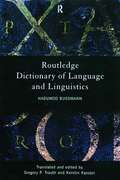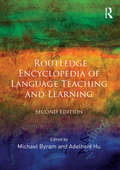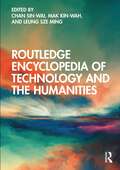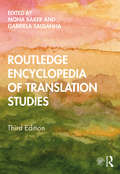- Table View
- List View
Rick Steves German Phrase Book & Dictionary (Rick Steves Travel Guide)
by Rick StevesHallo! From ordering bratwurst in Berlin to making new friends in Munich, it helps to speak some of the native tongue in Germany. Rick Steves offers well-tested German words and phrases that come in handy in a variety of situations. Inside you'll find:Key phrases for everyday circumstances, complete with phonetic spellingAn English-German and German-English dictionaryTips for small talk and local lingo with Rick's signature sense of humorA tear-out cheat sheet for continued language practice as you relax at a biergarten (no internet connection required!)Informative, concise, and practical, Rick Steves German Phrase Book & Dictionary is an essential item for any traveler's pocket.
Rick Steves Italian Phrase Book & Dictionary (Rick Steves Travel Guide)
by Rick StevesBuon giorno! From ordering calamari in Venice to making new friends in Tuscan hill towns, it helps to speak some of the native tongue in Italy. Rick Steves offers well-tested Italian words and phrases that come in handy in a variety of situations. Inside you'll find:Key phrases for use in everyday circumstances, complete with phonetic spellingAn English-Italian and Italian-English dictionaryTips for small talk and local lingo with Rick's signature sense of humor A tear-out cheat sheet for continued language practice as you wait in line at the Sistine Chapel (no internet connection required!)Informative, concise, and practical, Rick Steves Italian Phrase Book is an essential item for any traveler's pocket.
Rick Steves Portuguese Phrase Book and Dictionary (Rick Steves Travel Guide)
by Rick StevesOlá! From ordering vinho verde in the Douro Valley to making new friends in Lisbon, it helps to speak some of the native tongue in Portugal. Rick Steves offers well-tested Portuguese words and phrases that come in handy in a variety of situations. Inside you'll find:Key phrases for use in everyday circumstances, complete with phonetic spellingAn English-Portuguese and Portuguese-English dictionaryTips for small talk and local lingo with Rick's signature sense of humorA tear-out cheat sheet for continued language practice as you relax on the beach (no internet connection required!) Informative, concise, and practical, Rick Steves Portuguese Phrase Book & Dictionary is an essential item for any traveler's pocket.
Rick Steves Spanish Phrase Book & Dictionary (Rick Steves Travel Guide)
by Rick StevesFrom ordering tapas in Madrid to making new friends in Costa del Sol, it helps to speak some of the native tongue in Spain. Rick Steves offers well-tested Spanishwords and phrases that come in handy in a variety of situations. Inside you'll find:Key phrases for use in everyday circumstances, complete with phonetic spellingAn English-Spanish and Spanish-English dictionaryTips for small talk and local lingo with Rick's signature sense of humor A tear-out cheat sheet for continued language practice as you wait in line for the Guggenheim Bilbao (no internet connection required!)Informative, concise, and practical, Rick Steves Spanish Phrase Book is an essential item for any traveler's pocket.
Rick Steves' French Phrase Book & Dictionary (Rick Steves)
by Rick StevesBonjour! From ordering a café au lait in Paris to making new friends in the Loire Valley, it helps to speak some of the native tongue. Rick Steves, bestselling author of travel guides to Europe, offers well-tested phrases and key words to cover every situation a traveler is likely to encounter. This handy guide provides key phrases for use in everyday circumstances and comes complete with phonetic spelling, an English-French and French-English dictionary, the latest information on European currency and rail transportation, and even a tear-out cheat sheet for continued language practice as you wait in line at the Louvre. Informative, concise, and practical, Rick Steves' French Phrase Book and Dictionary is an essential item for any traveler's sac à dos.
Rick Steves' German Phrase Book & Dictionary (Rick Steves)
by Rick StevesGuten Tag! From ordering bratwurst in Munich to making new friends in the Rhine Valley, it helps to speak some of the native tongue. Rick Steves, bestselling author of travel guides to Europe, offers well-tested phrases and key words to cover every situation a traveler is likely to encounter. This handy guide provides key phrases for use in everyday circumstances, complete with phonetic spelling, an English-German and German-English dictionary, the latest information on European currency and rail transportation, and even a tear-out cheat sheet for continued language practice as you wait in line at the Gemaldegalerie. Informative, concise, and practical, Rick Steves' German Phrase Book and Dictionary is an essential item for any traveler's rucksack.
Rick Steves' Italian Phrase Book & Dictionary (Rick Steves' Ser.)
by Rick StevesBuon giorno! From ordering calamari in Venice to making new friends in Tuscan hill towns, it helps to speak some of the native tongue. Rick Steves, bestselling author of travel guides to Europe, offers well-tested phrases and key words to cover every situation a traveler is likely to encounter. This handy guide provides key phrases for use in everyday circumstances, complete with phonetic spelling, an English-Italian and Italian-English dictionary, the latest information on European currency and rail transportation, and even a tear-out cheat sheet for continued language practice as you wait in line at the Sistine Chapel. Informative, concise, and practical, Rick Steves' Italian Phrase Book and Dictionary is an essential item for any traveler's zainetto.
Rick Steves' Spanish Phrase Book & Dictionary (Rick Steves)
by Rick StevesFrom ordering tapas in Madrid to making new friends in Costa del Sol, it helps to speak some of the native tongue. Rick Steves, bestselling author of travel guides to Europe, offers well-tested phrases and key words to cover every situation a traveler is likely to encounter. This handy guide provides key phrases for use in everyday circumstances, complete with phonetic spelling, an English-Spanish and Spanish-English dictionary, the latest information on European currency and rail transportation, and even a tear-out cheat sheet for continued language practice as you wait in line at the Guggenheim Bilbao. Informative, concise, and practical, Rick Steves' Spanish Phrase Book and Dictionary is an essential item for any traveler's mochila.
Rights to Language: Equity, Power, and Education
by Robert PhillipsonRights to Language: Equity, Power, and Education brings together cutting-edge scholarship in language, education, and society from all parts of the world. Celebrating the 60th birthday of Tove Skutnabb-Kangas, it is inspired by her work in minority, indigenous, and immigrant education; multilingualism; linguistic human rights; and global language and power issues. Rights to Language situates issues of minorities and bilingual education in broader perspectives of human rights, power, and the ecology of language. The rich mix of papers serves to underline that the issues are comparable worldwide, that many disparate topics can cross-fertilize each other, and that our understanding of the issues can benefit from coverage that is global, reflective, and committed. A Web site with additional resource materials to this book can be found on http://www.cbs.dk/staff/phillipson/
Riḥla ilā Bilād al-‘Arab رحلة إلى بلاد العرب: A Comprehensive Introductory Course for Arabic Heritage Speakers
by Munther YounesRiḥla ilā Bilād al-‘Arab starts with the Arabic alphabet and gradually and systematically builds the reading and writing skills and mastery of Fuṣḥā grammar. As students develop their reading, writing, and grammar skills, they will be learning about Arab history, society, and culture. This book contextualizes Arabic grammar teaching with sufficient and relevant drills and exercises. Added personal and cultural interest is given by the diary of Amal, an American student of Arab descent, who travels to Jordan and Palestine. This textbook includes maps, illustrations, and photographs and is accompanied by audio on the companion website that can be viewed here: www.routledge.com/cw/younes . The book is designed for Arabic heritage students—students who can understand and speak an Arabic dialect (Egyptian, Iraqi, Moroccan, etc.) but are unfamiliar with Modern Standard Arabic, known as Fuṣḥā.
Rivalidad - Una historia de Cenicienta
by Sonya Writes Marta S. NovoaIn this book you will find two novellas in English paired with their Spanish translations. Due to the nature of translating and the differences between languages, the translations will not be an exact match to each other. Sometimes the wording between the two languages will be very similar, but in other places the wording will be quite different. You can use this book as a learning tool to comparatively study English and Spanish, learning from both the differences and the similarities. One way to use this book is to take different colored pencils to circle verbs or underline nouns and compare each paragraph to its counterpart. Where words and sentences are not an exact translation to each other, you can write notes and definitions on the lines provided in the margins to further your learning experience. The stories contained in this volume are Liberty – a Rapunzel story and Rivalry – a Cinderella story. Dos novelas en una y sus traducciones al español (castellano). En este libro encontrarás dos novelas en inglés emparejadas con sus traducciones al español (castellano). Debido a la naturaleza de la traducción y a las diferencias entre los idiomas, las traducciones no serán una coincidencia exacta entre sí. A veces la redacción entre los dos idiomas será muy similar, pero en otros lugares la redacción será muy diferente. Puedes utilizar este libro como una herramienta de aprendizaje para estudiar comparativamente el inglés y el español (castellano), aprendiendo tanto de las diferencias como de las similitudes. Una forma de usar este libro es tomar lápices de colores diferentes para circundar los verbos o subrayar sustantivos y comparar cada párrafo con su contraparte. Ya que las palabras y las frases no son una traducción exacta entre sí, puedes escribir notas y definiciones en las líneas proporcionadas en los márgenes para aumentar tu experiencia de aprendizaje. Las historias contenidas en este volum
Romance Languages
by Ti Alkire Carol RosenTi Alkire and Carol Rosen trace the changes that led from colloquial Latin to five major Romance languages, those which ultimately became national or transnational languages: Spanish, French, Italian, Portuguese, and Romanian. Trends in spoken Latin altered or dismantled older categories in phonology and morphology, while the regional varieties of speech, evolving under diverse influences, formed new grammatical patterns, each creating its own internal regularities. Documentary sources for spoken Latin show the beginnings of this process, which comes to full fruition in the medieval emergence of written Romance languages. This book newly distills the facts into an appealing program of study, including exercises, and makes the difficult issues clear, taking well motivated and sometimes innovative stands. It provides not only an essential guide for those new to the topic, but also a reliable compendium for the specialist.
Romanian: An Essential Grammar (Routledge Essential Grammars)
by Ramona GönczölNow in its second edition, Romanian: An Essential Grammar is a concise, user-friendly guide to modern Romanian. It takes the student through the essentials of the language, explaining each concept clearly and providing many examples of contemporary Romanian usage. This fully revised second edition contains: • a chapter of each of the most common grammatical areas with Romanian and English examples • extensive examples of the more difficult areas of the grammar • a section with exercises to consolidate the learning and the answer key • a list of useful verbs • an appendix listing useful websites for further information • a glossary of grammatical terms used in the book • a useful bibliographical list. Suitable for both classroom use and independent study, this book is ideal for beginner to intermediate students.
Romanian: An Essential Grammar (Routledge Essential Grammars)
by Ramona GönczölThis book is suitable for independent and classroom learners, ideal for the beginner to intermediate student, and takes the reader through the essentials of the language explaining each concept clearly and providing many examples of contemporary Romanian usage. The book contains: a chapter on each of the most common grammatical areas with Romanian and English examples extensive examples of the more difficult areas of the grammar an appendix listing relevant websites for further information on the Romanian language.
Romanticism, Philosophy, and Literature
by Michael N. Forster Lina SteinerThis book offers a broad re-evaluation of the key ideas developed by the German Romantics concerning philosophy and literature. It focuses not only on their own work, but also on that of their fellow travelers (such as Hölderlin) and their contemporary opponents (such as Hegel), as well as on various reactions to and transpositions of their ideas in later authors, including Coleridge, Byron, Kierkegaard, Nietzsche, and Dostoevsky.
Rome Eternal: The City as Fatherland
by Guy LanoueWhat does 'Roman' mean? How does the mythical city touch people's identities, values and attitudes? In the long-established and official imaginary of the West, Rome is the citta dell'arte, the city of faith, an heirloom city inspired by the traces of ancient Empire, by the brooding aura of the Church, by Hollywood fairy-tale romance, and by the spicy tang of veiled decadence. But what of its contemporary residents? Are they now merely guides and waiters servicing throngs of tourists indifferent to the city's contemporary charms? Guy Lanoue, a former resident of Rome, explores how Romans live the modern myth of Rome Eternal. Since the 19th century, it has defined an important community, the fatherland, a home-spun society where the rules of everyday life become 'tradition': ways of eating, dressing, making and keeping friends and acquaintances, 'proper' ways of speaking and a hard to define but nonetheless tangible air of composure. Guy Lanoue is a Professor of Anthropology at the Universite de Montreal.
Rooted in Strength: Using Translanguaging to Grow Multilingual Readers and Writers
by Laura Ascezni-Moreno Cecilia EspinozaEspinosa and Ascenzi-Moreno demonstrate how our emergent bilingual students who speak two or more languages in their daily lives― thrive when they are able to use “translanguaging” to tap the power of their entire linguistic and sociocultural repertoires. <p><p>Additionally, the authors present rich and thoughtful literacy practices that propel emergent bilinguals into reading and writing success. The core of this approach is honoring and leveraging the language and cultural resources emergent bilinguals bring to school― and rooting instruction in their strengths. Knowing more than one language is, indeed, a gift to the classroom! Includes a foreword by Ofelia Garcia.
Routledge Course In Modern Mandarin Chinese Level 2 (Simplified)
by Claudia Ross Baozhang He Pei-Chia Chen Meng YehThe Routledge Course in Mandarin Chinese is a two-year undergraduate course for students with no prior background in Chinese study. Designed to build a strong foundation in both the spoken and written language it develops all the basic skills such as pronunciation, character writing, word use and structures, while placing strong emphasis on the development of communicative skills. <P><P>The complete course consists of Textbook Level 1, Workbook level 1 - including free CDs, Textbook level 2 and workbook level 2 -including free CDs. All books are available separately in simplified as well as traditional characters and take the students from complete beginner to post-intermediate level. <P><P>Textbook Level 2 incorporates the innovative features of Level 1 including the separation of vocabulary from characters, a "basic to complex" introduction of grammatical structures, a comprehensive companion workbook with extensive practice in all language skills and functions, and a Teachers’ Manual. <P><P> Level 2 adds a "Narrative" Component to support the learner as they move from spoken Mandarin to formal written Chinese, and from the comprehension and production of short sentences to paragraphs and essays. Level 2 of this Course in Modern Mandarin bridges the gap that characterizes the transition between basic level Chinese courses and more advanced work. The Narrative Component includes: <P><P> Model narratives that introduce formal written Chinese with explanations of the features of each narrative. <P><P> Focus on narrative function including description, comparison, explanation, persuasion, and hypothesis. <P><P> Reading and writing assignments that guide students to internalize model structures, to read for information, and to compose original essays for specific purposes. <P><P> The course is also fully supported by an interactive companion website which contains a wealth of additional resources for both teachers and students. <P><P> Teachers will find lesson plans in both English and Mandarin, providing a weekly schedule and overall syllabus for fall and spring, as well as activities for each lesson and answer keys. <P><P> Students will be able to access downloadable character practice worksheets along with interactive pronunciation, vocabulary and character practice exercises. All the audio material necessary for the course is also available online and conveniently linked on screen to the relevant exercises for ease-of-use. <P><P> For more information about the course and to access these additional resources, please visit the companion website at www.routledge.com/textbooks/9780415472517 For bundle discounts please visit: http://www.routledge.com/books/details/9780415533072/ <P><P><i>Advisory: Bookshare has learned that this book offers only partial accessibility. We have kept it in the collection because it is useful for some of our members. Benetech is actively working on projects to improve accessibility issues such a
Routledge Course in Modern Mandarin Chinese Level 2 Traditional
by Claudia Ross Baozhang He Meng Yeh Pei-chia ChenThe Routledge Course in Mandarin Chinese is a two-year undergraduate course for students with no prior background in Chinese study. Designed to build a strong foundation in both the spoken and written language it develops all the basic skills such as pronunciation, character writing, word use and structures, while placing strong emphasis on the development of communicative skills. The complete course consists of Textbook Level 1, Workbook level 1 - including free CDs, Textbook level 2 and workbook level 2 -including free CDs. All books are available separately in simplified as well as traditional characters and take the students from complete beginner to post-intermediate level. Textbook Level 2 incorporates the innovative features of Level 1 including the separation of vocabulary from characters, a "basic to complex" introduction of grammatical structures, a comprehensive companion workbook with extensive practice in all language skills and functions, and a Teachers’ Manual. Level 2 adds a "Narrative" Component to support the learner as they move from spoken Mandarin to formal written Chinese, and from the comprehension and production of short sentences to paragraphs and essays. Level 2 of this Course in Modern Mandarin bridges the gap that characterizes the transition between basic level Chinese courses and more advanced work. The Narrative Component includes: Model narratives that introduce formal written Chinese with explanations of the features of each narrative. Focus on narrative function including description, comparison, explanation, persuasion, and hypothesis. Reading and writing assignments that guide students to internalize model structures, to read for information, and to compose original essays for specific purposes. The course is also fully supported by an interactive companion website which contains a wealth of additional resources for both teachers and students. Teachers will find lesson plans in both English and Mandarin, providing a weekly schedule and overall syllabus for fall and spring, as well as activities for each lesson and answer keys. Students will be able to access downloadable character practice worksheets along with interactive pronunciation, vocabulary and character practice exercises. All the audio material necessary for the course is also available online and conveniently linked on screen to the relevant exercises for ease-of-use. For more information about the course and to access these additional resources, please visit the companion website at www.routledge.com/textbooks/9780415472517 For bundle discounts please visit: http://www.routledge.com/books/details/9780415533089/
Routledge Course in Modern Mandarin Chinese Level 2 Traditional: The Routledge Course Textbook Level 1 (Modern Grammars Ser.)
by Claudia Ross Baozhang He Meng Yeh Pei-chia ChenThe Routledge Course in Mandarin Chinese is a two-year undergraduate course for students with no prior background in Chinese study. Designed to build a strong foundation in both the spoken and written language it develops all the basic skills such as pronunciation, character writing, word use and structures, while placing strong emphasis on the development of communicative skills.The complete course consists of Textbook Level 1, Workbook level 1 - including free CDs, Textbook level 2 and workbook level 2 -including free CDs. All books are available separately in simplified as well as traditional characters and take the students from complete beginner to post-intermediate level. Textbook Level 2 incorporates the innovative features of Level 1 including the separation of vocabulary from characters, a "basic to complex" introduction of grammatical structures, a comprehensive companion workbook with extensive practice in all language skills and functions, and a Teachers’ Manual. Level 2 adds a "Narrative" Component to support the learner as they move from spoken Mandarin to formal written Chinese, and from the comprehension and production of short sentences to paragraphs and essays. Level 2 of this Course in Modern Mandarin bridges the gap that characterizes the transition between basic level Chinese courses and more advanced work. The Narrative Component includes: Model narratives that introduce formal written Chinese with explanations of the features of each narrative Focus on narrative function including description, comparison, explanation, persuasion, and hypothesis Reading and writing assignments that guide students to internalize model structures, to read for information, and to compose original essays for specific purposes. The course is also fully supported by an interactive companion website which contains a wealth of additional resources for both teachers and students. Teachers will find lesson plans in both English and Mandarin, providing a weekly schedule and overall syllabus for fall and spring, as well as activities for each lesson and answer keys Students will be able to access downloadable character practice worksheets along with interactive pronunciation, vocabulary and character practice exercises. All the audio material necessary for the course is also available online and conveniently linked on screen to the relevant exercises for ease-of-use For more information about the course and to access these additional resources, please visit the companion website at www.routledge.com/textbooks/9780415472517For bundle discounts please visit: http://www.routledge.com/books/details/9780415533089/
Routledge Course in Modern Mandarin Chinese Workbook 2 (Traditional)
by Claudia Ross Baozhang He Pei-Chia Chen Meng YehThe Routledge Course in Mandarin Chinese is a two-year undergraduate course for students with no prior background in Chinese study. Designed to build a strong foundation in both the spoken and written language it develops all the basic skills such as pronunciation, character writing, word use and structures, while placing strong emphasis on the development of communicative skills. The complete course consists of Textbook Level 1, Workbook level 1 - including free CDs, Textbook level 2 and Workbook level 2 -including free CDs. All books are available separately in simplified as well as traditional characters and take the students from complete beginner to post-intermediate level. For more information about the course and additional resources, please visit the companion website at www.routledge.com/textbooks/9780415472517 Workbook Level 2 is designed to accompany Textbook Level 2 lesson by lesson, and offers exercises for homework, independent study and classroom use. The exercises focus on interpersonal, interpretative and presentational modes of communication while helping students to consolidate the vocabulary, characters, and structures introduced in each lesson. At the conclusion of this course, students will be able to read page-length texts for information, listen to and comprehend extended narratives on a variety of topics, and communicate a broad range of information orally and in writing. The course is also fully supported by an interactive companion website which contains a wealth of additional resources for both teachers and students. Teachers will find lesson plans in both English and Mandarin, providing a weekly schedule and overall syllabus for fall and spring, as well as activities for each lesson and answer keys. Students will be able to access downloadable character practice worksheets along with interactive pronunciation, vocabulary and character practice exercises. All the audio material necessary for the course is also available online and conveniently linked on screen to the relevant exercises for ease-of-use. For more information about the course and to access these additional resources, please visit the companion website at www.routledge.com/textbooks/9780415472517 For bundle discounts please visit: http://www.routledge.com/books/details/9780415533089/
Routledge Dictionary of Language and Linguistics
by Hadumod BussmannThe Routledge Dictionary of Language and Linguistics is a unique reference work for students and teachers of linguistics. The highly regarded second edition of the Lexikon der Sprachwissenschaft by Hadumod Bussmann has been specifically adapted by a team of over thirty specialist linguists to form the most comprehensive and up-to-date work of its kind in the English language. In over 2,500 entries, the Dictionary provides an exhaustive survey of the key terminology and languages of more than 30 subdisciplines of linguistics. With its term-based approach and emphasis on clear analysis, it complements perfectly Routledge's established range of reference material in the field of linguistics.
Routledge Encyclopedia of Language Teaching and Learning
by Michael Byram Adelheid HuThe Routledge Encyclopedia of Language Teaching and Learning is an authoritative reference dealing with all aspects of this increasingly important field of study. Offering a comprehensive range of articles on contemporary language teaching and its history, it has been produced specifically for language teaching professionals and as a reference work for academic studies at postgraduate level. In this new edition, every single entry has been reviewed and updated with reference to new developments and publications. Coverage has been expanded to reflect new technological, global and academic developments, with particular attention to areas such as online and distance learning, teacher and learner cognition, testing, assessment and evaluation, global English and teacher education. Themes and disciplines covered include: Methods and materials, including new technologies and materials development Contexts and concepts, such as mediation, risk-taking in language learning and intercomprehension Influential figures from the early days of language teaching to the contemporary Related disciplines, such as psychology, anthropology and corpus linguistics It covers the teaching of specific languages, including Japanese, Chinese, Arabic and African languages, as well as English, French, German and Spanish. There are thirty five overview articles dealing with issues such as communicative language teaching, early language learning, teacher education and syllabus and curriculum design. A further 160 entries focus on topics such as bilingualism, language laboratories and study abroad. Numerous shorter items examine language and cultural institutions, professional associations and acronyms. Multiple cross-references enable the user to browse from one entry to another, and there are suggestions for further reading. Written by an international team of specialists, the Routledge Encyclopedia of Language Teaching and Learning is an invaluable resource and reference manual for anyone with a professional or academic interest in the subject.
Routledge Encyclopedia of Technology and the Humanities
by Chan Sin-Wai Mak Kin-Wah Leung Sze MingRoutledge Encyclopedia of Technology and the Humanities is a pioneer attempt to introduce a wide range of disciplines in the emerging field of techno-humanities to the English-reading world.This book covers topics such as archaeology, cultural heritage, design, fashion, linguistics, music, philosophy, and translation. It has 20 chapters, contributed by 26 local and international scholars. Each chapter has its own theme and addresses issues of significant interest in the respective disciplines. References are provided at the end of each chapter for further exploration into the literature of the relevant areas. To facilitate an easy reading of the information presented in this volume, chapters have been arranged according to the alphabetical order of the topics covered.This Encyclopedia will appeal to researchers and professionals in the field of technology and the humanities, and can be used by undergraduate and graduate students studying the humanities.
Routledge Encyclopedia of Translation Studies
by Mona Baker Gabriela SaldanhaThe Routledge Encyclopedia of Translation Studies remains the most authoritative reference work for students and scholars interested in engaging with the phenomenon of translation in all its modes and in relation to a wide range of theoretical and methodological traditions. This new edition provides a considerably expanded and updated revision of what appeared as Part I in the first and second editions. Featuring 132 as opposed to the 75 entries in Part I of the second edition, it offers authoritative, critical overviews of additional topics such as authorship, canonization, conquest, cosmopolitanism, crowdsourced translation, dubbing, fan audiovisual translation, genetic criticism, healthcare interpreting, hybridity, intersectionality, legal interpreting, media interpreting, memory, multimodality, nonprofessional interpreting, note-taking, orientalism, paratexts, thick translation, war and world literature. Each entry ends with a set of annotated references for further reading. Entries no longer appearing in this edition, including historical overviews that previously appeared as Part II, are now available online via the Routledge Translation Studies Portal. Designed to support critical reflection, teaching and research within as well as beyond the field of translation studies, this is an invaluable resource for students and scholars of translation, interpreting, literary theory and social theory, among other disciplines.
